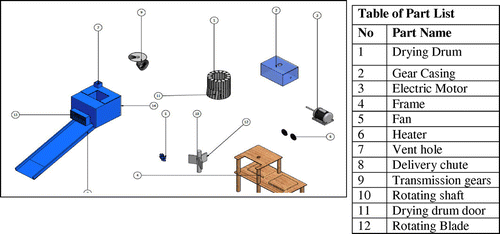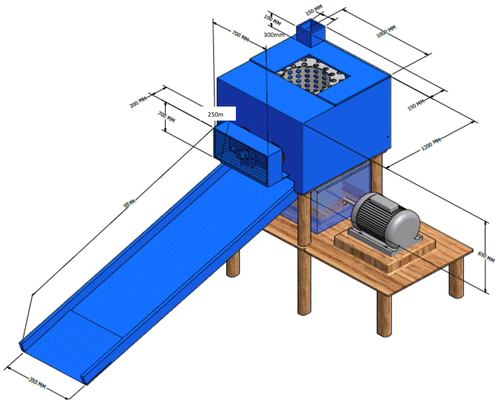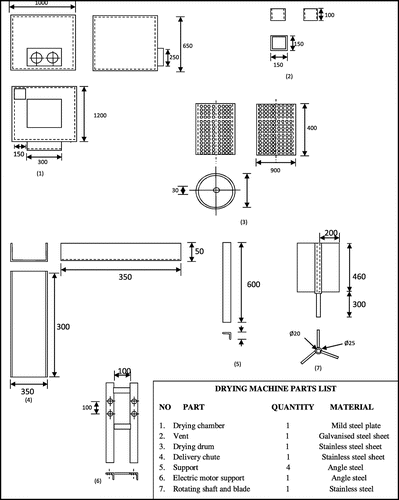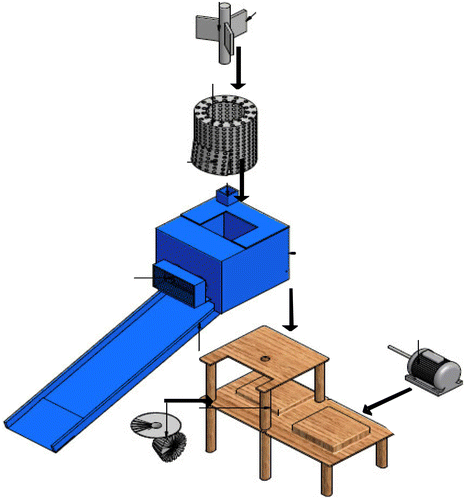 ?Mathematical formulae have been encoded as MathML and are displayed in this HTML version using MathJax in order to improve their display. Uncheck the box to turn MathJax off. This feature requires Javascript. Click on a formula to zoom.
?Mathematical formulae have been encoded as MathML and are displayed in this HTML version using MathJax in order to improve their display. Uncheck the box to turn MathJax off. This feature requires Javascript. Click on a formula to zoom.Abstract
The process of making pounded yam, from yam, Dioscorea spp., which is mostly consumed by people of sub-Sahara region as source of carbohydrate is energy consuming, therefore, the pounded yam flour, commonly called poundo yam, through which pounded yam is prepared faster and easier, has become popular in West Africa. Although there is an existing niche market for the design and production of poundo yam processing plant, proper drying, one of the most important stages in the production line of poundo yam flour is drying to remove moisture from parboiled (a stage before drying) yam chips still remains the limitation to an effective application of the processing plant in the food industry. The development and performance evaluation of an effective drier that will allow the movement of the dried yam chips to the next machine in poundo yam process plant and its suitability to the food industrial applications was carried out in this research. The volume of the drying drum was estimated to be 0.03 m3. The capacity of the dryer is the amount of yam the drying drum can contain per batch. 28 kg of yam chips was dried at a temperature of 50°C for 3.7 h being the safe drying temperature. The efficiency of the machine was evaluated by estimating the moisture removal rate from the yam in comparison with the power consumption rate and this gave 72.71%.
Public Interest Statement
Pounded yam flour (poundo yam), a faster and easier means of preparing pounded yam has become popular and acceptable contributing more than 200 dietary calories per capital daily for over 150 million people in West Africa and serves as an important source of income. It is produced from yam, Dioscorea (spp.) one of the oldest known recipes to man consumed mostly by people of sub-Sahara region as source of carbohydrate. However, its production process from yam is energy consuming, hence the need for an efficient process for its mass production. Drying, the major process in the plant is the focus of this work to develop and evaluate the performance of an effective drier and its suitability for food industry applications. Components of the drier: drying-drum, heating element, rotating shaft, frame and delivery chute. The volume of the drying drum is 0.03 m3 with capacity to dry 28 kg of yam chips at 50°C for 3.7 h. The efficiency of the machine was evaluated to be 72.71%.
1. Introduction
The capacity to preserve food is directly related to the level of technological development. The slow progress in upgrading traditional food processing and preservation techniques in West Africa contributes to food and nutrition insecurity in the sub-region (Ayodeji, Olabanji, & Adeyeri, Citation2012). Modern methods of food processing such as extrusion cooking, explosion puffing, and instantiation appear to make the starch in food readily digestible.
Yam, Dioscorea (spp.) is one of the oldest known recipes to man. It is a tuber crop, which belongs to the class of carbohydrate and has been part of the African meal for centuries. In the humid tropical countries of West Africa, yams are one of the most highly regarded food products and are closely integrated into the social, cultural, economic and religious aspects of life. Traditional ceremonies still accompany yam production, indicating the high status given to the plant. Its starchy nature allows yam to form a bond, when it is beaten in a mortar, which is then consumed as meal with a choice soup. Pounded yam is a staple food consumed by almost every tribe in Nigeria. The indigenous process of preparing it is very laborious. It requires physical pounding by two or more people, using mortars and pestle.
Yam, Dioscorea (spp.) is an important source of carbohydrate for many people of the sub-Sahara region, especially in the yam zone of West Africa (Akissoe, Mestres, Hounhouigan, & Nago, Citation2003). Yam contributes more than 200 dietary calories per capital daily for more than 150 million people in West Africa and serves as an important source of income to the people. One of the commonly found varieties in Nigeria is Dioscorea (D.) rotunda (white yam) (Coursey, Citation1967). According to Egbe, Agbor, and Treche (Citation1984) D. rotunda is made up of 67% moisture. The percentage composition of nutrient in Dioscorea (D.) rotunda specie in dry condition is 80% starch, 7% protein, 7% minerals, 3% fibre and 1.7% lipids; 100 g of the yam give 385 kcal energy.
The world production of yam was estimated as 28.1 million tonnes in 1993. 96% of this production came from West Africa, the main producers being Nigeria with 71% of world production; Côte d’Ivoire 8.1%; Benin 4.3% and Ghana 3.5% (Tropical Roots & Tubers, Citation2011). Regrettably, the larger percentage of the yearly turnover in yam harvest are not been fully utilized which has informed the need for the development of custom made dryer as integrated into the poundo yam flour process plant (Ayodeji et al., Citation2012) to process yam into instant poundo yam flour to be consumed by people when there is scarcity. In order to achieve the aim of this research, the following questions were answered; the location and orientation of the dryer in the process plant to permit continuous flow of material, the physical and chemical properties of the yam flowing through the process plant at the location of the dryer, the efficiency of the dryer and the quality of the yam chips produced from the developed dryer.
2. Literature review
Drying is the process of removing moisture from a substance. This process is imperative to the poundo yam flour process plant because the parboiled yam chips have to be dried before milling and sieving operations. Various types of industrial driers have been developed for different purposes. However, a dryer required for poundo yam flour process plant is expected to fit into the plant as a whole to ensure that the flow of the yam chips to next operation in the process is done automatically. One of the industrial dryers in use is the rotary driers. These are inclined a few degrees and rotate slowly, typically 5–20 rpm. Product moves through the dryer continuously, and hot air is circulated sometimes in the same direction and sometimes in the opposite direction of the product flow. Rotary dryers vary in length from a few feet to over 300 feet. Spray dryers have a cylindrical or conical vertical chamber into which liquid or slurry is sprayed. As liquid food droplets circulate, the hot air moving through the chamber evaporates the water; a cyclone is used to separate solids, typically with moisture content less than 5%, from exhaust air (Singh & Heldman, Citation2001; William, Citation1990).
Band dryers use a perforated metal conveyor to transport wet foodstuff. Hot air is then circulated through the conveyor and the moist material to remove water. Band dryers run continuously and are well suited for products that require gentle handling. Tray dryers are usually operated in batch mode using shelves to hold product and circulating air over the material. Designs range from a simple oven to a rotating conformation of stacked trays. The latter design makes continuous feeding possible as the material enters on the top tray and is then automatically scraped onto successively lower trays as more and more moisture is removed until it leaves the bottom tray sufficiently dry. Tunnel dryers convey heated air and a series of trays containing wet material through a tunnel. The sides of the tunnel may also be heated to enhance drying.
Another type of industrial drier is fluidized bed dryer; they combine a perforated plate with regulated air flow rates such that the solid particles become suspended about the plate. These dryers can be operated in batch or continuous flow mode. Drum dryers use conduction heating. Wet material is dropped onto one or more heated drums. The water evaporates, and the dry material is scraped off with a knife. This can be done in a vacuum chamber. Pneumatic dryers use a fast-moving stream of air to convey the material up through the chamber. A cyclone at the top allows the dried material to be collected.
One of the oldest of all drying methods is Freeze drying. Ancient Peruvian Incas stored potatoes and other foodstuffs high in the mountains during the winter. The cold temperatures froze the food and the water inside slowly evaporated under the low air pressure of the high altitude.
Today, material is first frozen and then placed in a vacuum. This makes it possible to vaporize the frozen water without going through the liquid phase; this is known as sublimation. Heat is applied to accelerate the sublimation process, and, finally, condensers remove the vaporized water from the vacuum chamber.
3. Methodology
3.1. Design concept
The major components of the drying machine are the drying drum (enclosed in the drying chamber), the heating element, the rotating shaft and blades, the frame and the delivery chute, the rotating shaft supported in a bearing. The drying chamber is square in shape and it encloses the drying drum. Holes are created in front of the drying chamber where the heating elements are positioned to heat the drying drum. Blades are attached to the rotating shaft which sweeps the chips of yam in the drying drum to ensure uniform temperature distribution. Fans are placed outside the drying chamber and are aligned directly with the heaters to blow the hot air to the perforated drying drum. Temperature control in the drying drum is achieved by fitting a thermostat to the drying drum to ensure that the temperature does not exceed 50°C (drying temperature of yam) (Oke et al., Citation2009). The rotation of the shaft is as a result of power transmitted to it from the electric motor through a bevel gear power transmission. Figures – show the various views of components making up the drying machine.
3.2. Design consideration
A variety of factors were put into consideration before the design of the machine was done. The factors considered include:
| (i) | ease of assembly and disassembly of the machine parts; | ||||
| (ii) | integration of the drying machine into the poundo yam flour processing plant; | ||||
| (iii) | height of the machine; | ||||
| (iv) | size and geometry of the sliced yams; | ||||
| (v) | yam drying temperature; and | ||||
| (vi) | time taken to dry the yam chips. | ||||
3.3 Design analysis
The drying drum is cylindrical in cross-section and it is perforated with holes 10 mm diameter and separated by a distance of 10 mm. The drying drum is positioned inside the drying chamber and supported by bearings to prevent it from touching the rotating shaft.
The volume of the drying drum is obtained from Equation (1).(1)
(1)
where Vdr is the volume of the drying drum; Ldr is the length of the drying drum; and Ddr is the diameter of the drying drum.
The function of the rotating shaft is to provide rotary motion for the blades so that it can move the yam chips as they receive heat from the heater. The reason for this is action is to ensure proper circulation of heat in the drying drum so that all the yam chips receive heat at the same rate. The diameter of the rotating shaft was obtained using Equation (2) according to (Khurmi & Gupta, Citation2009).(2)
(2)
(Oke et al., Citation2009)
where Drd is the diameter of the auger shaft (m); Ss is the allowable shear stress (N/m2); Kb is the combined shock and fatigue factor applied to bending moment; Kt is the combined shock and fatigue factor applied to torsional moment; Mbm is the maximum bending moment (Nm); and Mtm is the maximum torsional moment.
The frame supports, the drying chamber, the rotating shaft and blades, the electric heater and fans, the delivery chute and the electric motor. The crippling or buckling load that the frame of the machine can withstand was estimated using Equation (3) (Khurmi & Gupta, Citation2010).(3)
(3)
where C is the constant representing the end conditions of the column or end fixity coefficient = 4 for welded and bolted joints; E is the modulus of elasticity or young’s modulus for the material of the column; A is the area of cross section; l is the length of column; and k is the least radius of gyration.
where:
, such that I is called polar moment of area.
The isometric view, working drawing and the assembly drawing of the machine are as shown in Figures – respectively.
3.4. Material selection
Material selected for the fabrication of the drying machine is tabulated as shown in Table . The materials were selected in view to avoid contamination with the food material, the functionality of the material and cost effectiveness of production of the dryer.
Table 1. Material selection for fabrication of the drying machine
4. Result and discussion
4.1. Performance evaluation of the dryer
The fabricated machine was run without load with a one-phase 350 rpm, 1 hp electric motor until the drying chamber attained a temperature of 50°C and the calibrated thermostat was set at that temperature. Thereafter, the parboiled yam chips were fully loaded into the drying drum and heated until bone dry yam was obtained. The test was repeated for four more times and the mass of the yam before and after drying was recorded for each batch. Table shows the results of the performance tests and Figure (a) and (b) shows the fabricated drying machine.
Table 2. Results of the performance test at drying temperature of 50°C and yam slice thickness of 10 mm
Figure 5. (a) The fabricated drying drum and rotating blade machine and (b) The fabricated drying machine.
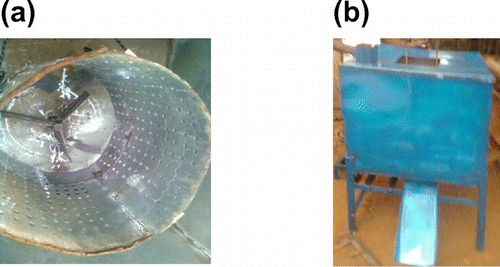
The amount of moisture removed from the yam was obtained using Equation (4) according to Khurmi and Gupta (Citation2009):(4)
(4)
where Mr is the amount of moisture removed; M0 is the initial moisture content of the yam; mi is the initial mass of yam; Mf is the final moisture content of the yam; and Mr = 20.32 kg.
The efficiency of the dryer (DE) was obtained from Equation (5).(5)
(5)
where w is weight of the material output per hour of the dryer on bone dry basis; min and mout is moisture content in feed material and output material of the dryer, respectively, expressed as kg moisture/kg bone dry material is 75 and 8.9%; Tsin and Tsout is Temperature of the material being dried at the dryer inlet and outlet =80 and 50°C respectively; Le is Latent heat of evaporation of water at the exhaust temperature of the dryer =2,256.3 kJ/kg and Hin is Thermal energy input rate to dryer.
Thermal energy input to the dryer:(6)
(6)
where m is the mass of moisture removed; Ch-in is the specific heat of humid air; Tin is the input temperature; and Tamb is the ambient temperature.
But Ch−in = Cpa + hamb + Cpv
where Ch−in = 3.58 kJ/kg/°C; Cpa is the specific heat capacity of dry air =1.0 kJ/kg/°C; Cpv is the specific heat of water vapour =1.88 kJ/kg/°C; and Tamb is the average ambient temperature =28.5°C.
Therefore Hin = 3,928.26 kJ/kg and DE = 72.71%.
Also the percentage moisture loss from the yam chips was obtained using Equation (6):(7)
(7)
where PM is the percentage moisture loss; mi is the initial mass of the parboiled yam; mf is the final mass of the parboiled yam after drying; and PM = 75.0%.
The drying rate of the yam drying machine (Dr) is the ratio of the total amount of moisture removed from the yam (Mr) to the time spent (t) by the machine, thus:(8)
(8)
Dr = 5.49 kg/h
The moisture removal rate (drying rate) of the drying machine shows that it is suitable for the purpose of poundo yam flour making. The moisture content of the output from the dryer being less than 9% is enough to give the poundo yam flour a good shelf life.
5. Conclusion
The developed drying machine for the poundo yam process plant permitted the continuous flow of material through the process plant and the materials selected in direct contact with the parboiled yam loaded were non-contaminant. The machine powered through electric motor, gave quality yam chips with 8.9% moisture content after 3.7 h which is less than 9% moisture content; an indication of an extended shelf life of the poundo yam chips upon milling to flour with an overall drying efficiency of 72.71%. The total cost of the fabricating the machine was # 47,100 ($236.68).
Additional information
Funding
Notes on contributors
S.P. Ayodeji
My research team is into development of process plants, Machine & System Design, Automation & Robotics and Applied Ergonomics. Some of the top publications of the team are: Conceptual design of a process plant for the production of plantain flour computer aided assembly animation of a tricycle for paraplegics; design of a process plant for the production of poundo yam; Development of yam peeling and slicing machine for a yam processing plant; Animated simulation of pilot soya beans oil production process plant; A control system for poundo yam flour processing plant; and Design and fabrication of an adaptive left throttling pedal for V-Boot wagon 230 for right paraplegic patient. Some ongoing works in the team include: Development of an automated process plant for Roselle tea particulate production; Performance evaluation of an automatic body mass index measuring machine; ergonomic evaluation of dynamic and post effect of vibration on earth moving equipment operators; and others.
References
- Akissoe, N., Mestres, C., Hounhouigan, J., & Nago, M. (2003). Biochemical origin of browning during the processing of fresh yam (Dioscorea spp.) into dried product. Journal of Agriculture and Food Chemistry, 53, 2552–2557.
- Ayodeji, S. P., Olabanji, O. M., & Adeyeri, M. K. (2012). Design of a process plant for the production of poundo yam. International Journal of Engineering, 6, 10–24.
- Coursey, O. (1967). Yams: Tropical agricultural series. London: Macmillan.
- Egbe, T., Agbor, T., & Treche, S. (1984). Variability in the chemical composition of yams grown in Cameroon. In E. R. Terry, E. v. Doku, O. B. Arene, & N. M. Mahungu (Eds.), Proceedings of 3rd Triennial Symposium of the International Society for Tropical Root Crops Production and uses in Africa (pp. 153–120). Cameroon.
- Khurmi, R. S., & Gupta, J. K. (2009). Machine design (14th ed, pp. 520–545, 608–612, 735–748, 763–770, 828–840, 965–967, 1088–1097). New Delhi: Eurasia Publishing House (Pvt) Ltd.
- Khurmi, R. S., & Gupta, J. K. (2010). Mechanical engineering design (pp. 511–534). New Delhi: S. Chand & Company Limited.
- Oke, M. O., Awonorin, S. O., Oyelade, O. J., Olajide, J. O., Olaniyan, G. O., & Sobukola, P. O. (2009). Some thermo-physical properties of yam cuts of two geometries. African Journal of Biotechnology, 8, 1300–1304.
- Singh, A., & Heldman, M. (2001). Introduction to food engineering (3rd ed., p. 567–574). San Diego, CA: Academic Press.
- Tropical Roots and Tubers. (2011). Yam. Retrieved May 6, 2011, from www.foodinfo.net/uk/products/rt/yam.htm
- William, G. (1990). Industrial Drying (p. 76–81). George Godwin Ltd..

